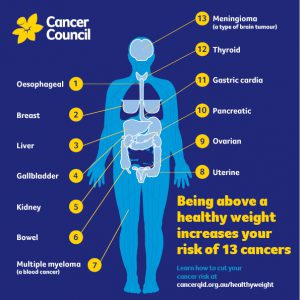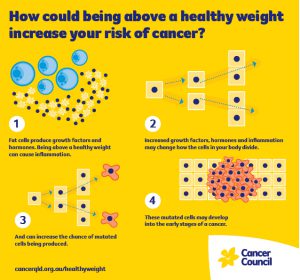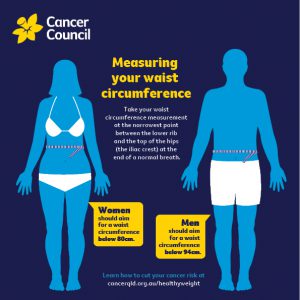In Queensland, about two-thirds of adults and one-quarter of children are above a healthy weight.
On this page you will find information on:
Cancer and weight
Being above a healthy weight increases the risk of 13 types of cancer – cancer of the oesophagus, breast, liver, gallbladder, kidney, bowel, multiple myeloma, meninges, thyroid, gastric cardia, pancreas, ovaries and uterus.

How can being above a healthy weight increase the risk of cancer?
The link between being overweight or obese and cancer is complex. Excess body fat can increase the level of hormones and growth factors in the blood and cause inflammation. This may change how the cells in your body divide and increase the chance of mutated cells being produced. These mutated cells may develop into early stages of cancer.

Causes of unhealthy weight gain
Your weight is usually determined by the balance between energy intake (kilojoules from food and drinks) and energy expenditure (energy used to carry out bodily functions as well as physical activity). If your energy intake is more than your body needs to function or uses being active, you are at risk of gaining weight. You can use the Eat for health daily energy requirements calculator to estimate your daily energy intake.
Good nutrition and regular physical activity can help to maintain a healthy weight. Being above a healthy weight, having a poor diet and not doing enough physical activity are modifiable risk factors for preventing cancer, second only to tobacco use. Find out more about how to eat healthily and drink less alcohol and take time to be active.
It is important to note that other factors can lead to weight gain, such as:
- Genetics
- Getting older
- Different life stages (e.g. pregnancy and menopause)
- Surrounding environment that can encourage unhealthy food choices
- Psychological factors such as stress
- Some diseases
- Metabolism (the body’s process that converts food into energy)
BMI calculator and waist circumference
Use both the Body Mass Index (BMI) and waist circumference to check if you are a healthy weight.
Body Mass Index (BMI)
The Body Mass Index compares your weight to your height. It is calculated by dividing your weight in kilograms by your height in metres squared. Enter your height and weight below to calculate your BMI.
Classification of adults according to BMI
| Classification | BMI |
| Underweight | Below 18.5 |
| Healthy Weight Range | 18.5-24.9 |
| Overweight | 25.0-29.9 |
| Obese I | 30.0-34.9 |
| Obese II | 35.0-39.9 |
| Obese III | 40 or more |
Note: The BMI is a useful measurement for most people over 18 years old. However, it is only an estimate and does not take into account age, gender, ethnicity and body composition, and therefore may not be accurate for people with greater muscle mass, older people and people who have reduced muscle mass.
Waist Circumference
Waist circumference is an indication of how much fat is around your abdomen. Having extra weight around your middle is a risk factor for many chronic diseases, including some cancers, type 2 diabetes and cardiovascular disease.

For professional advice on managing your weight, consult your doctor or an Accredited Practising Dietitian.
To find out more information, visit our resources page here.
Some of these health messages may not be appropriate for those experiencing cancer. If you are concerned about your weight, talk to your healthcare professional.
More Information
For more information about maintaining a healthy weight speak to your doctor or call Cancer Council 13 11 20.
Whether you have been diagnosed with cancer, or have a family member or friend who is affected by cancer, there are times when you may need support. Our professional services and support programs are here to help you.
The information available on this page should not be used as a substitute for advice from a properly qualified health professional who can advise about your own individual medical needs. It is not intended to constitute medical advice and is provided for general information purposes only. See our disclaimer.
